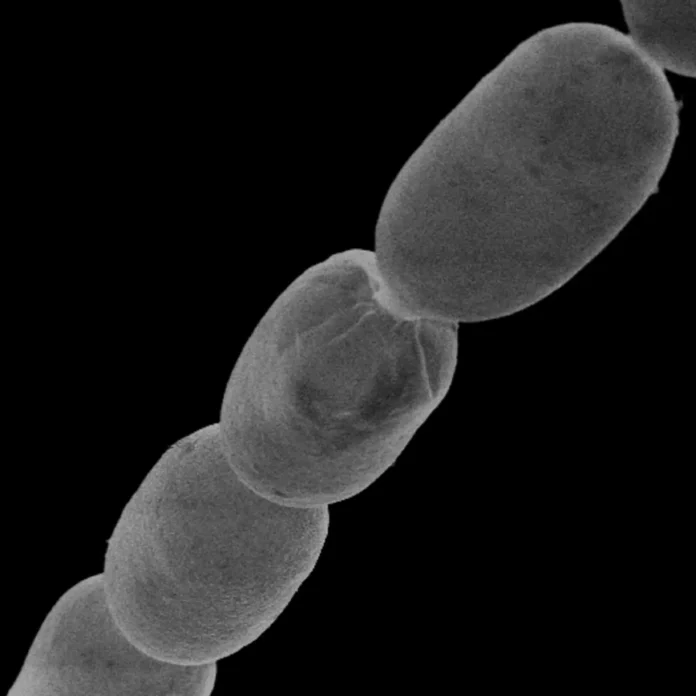Thiomargarita Bacteria:
For the centimeter-long Thiomargarita magnifica, the term “microorganism” is inaccurate.
The cells of the filamentous Thiomargarita magnifica are more complicated on the inside than the cells of most bacteria.
Thiomargarita Bacteria: Olivier Gros, a biologist found the bacteria in 2009
Some strange thread-like creatures live on rotting leaves that are buried in the mangroves of Guadeloupe, which is in the Caribbean. These filament-like organisms, up to a centimeter in length, are the biggest single-cell bacteria yet to be found. Thiomargarita magnifica are 50 times bigger than any other known bacteria. They live by oxidizing sulphur and have the name Thiomargarita magnifica.
Olivier Gros, a biologist who works at the University of the Antilles in the French West Indies, found the bacteria in 2009. He was exploring the mangroves of Guadeloupe, where he lives and works. Gros says, “At first, I thought it was something like a fungus or something — not bacteria, but maybe a eukaryote.” Eukaryotes, which include animals and plants, have complex cells with a nucleus and organelles like mitochondria. This is different from bacteria and archaea, which are simple microorganisms.
Thiomargarita Bacteria: Jean-Marie Volland, a marine biologist looked at the bacteria more closely
When Gros got back to his lab in Pointe-à-Pitre, Guadeloupe, he looked at what he had found with a microscope. Then he realized that what he was looking at wasn’t a eukaryote and that he’d found something special. In 2018, Jean-Marie Volland, a marine biologist at the Lawrence Berkeley National Laboratory in California, looked at the bacteria more closely.
He used a number of techniques, such as transmission electron microscopy and fluorescence in situ hybridization, to do this. He helped prove that it was a single cell by doing this. In February, the authors wrote about their results in a document called a “preprint.” Now, the results have been published in Science1.
Thiomargarita Bacteria: The bacterium is made up of a membrane called a vacuole
There are other big bacteria in the family Thiomargarita, but the next-biggest one is only about 750 micrometres long. In the mangroves, you can also find bacteria that look like threads, but these are made up of tens or hundreds of cells. Volland says that the T. magnifica is very special because its filament, which is one of the longest filaments in the mangrove, is made up of just one cell.
The bacterium is made up of a membrane called a vacuole that is filled with fluid and is not alive. Around the edge of this are structures that are attached to a membrane. The authors call these pepins and say they are like the organelles that are mostly found in eukaryotic cells.
Thiomargarita Bacteria: T. magnifica was stored in hundreds of thousands of pepins
Thiomargarita magnifica is notable for more than just how big it is. In other bacteria, the genetic material is usually just one circular chromosome that floats around inside the cell. The team found that the genetic information for T. magnifica was stored in hundreds of thousands of pepins. Each of these has DNA and ribosomes, which are molecular machines that make proteins based on instructions from DNA. Up to 700,000 copies of the genome are stored in the pepins as a whole.
Many questions remain. One of these is whether or not the mangrove’s environment, which has a lot of sulfur-containing molecules and sulfur-eating microbes, is important for this bacterium to live. And the pepins need to be looked at more closely to see if they all have the same mix of DNA, ribosomes, and proteins. Volland says, “We haven’t sequenced individual pepins. Instead, we’ve sequenced the whole cell, which has hundreds of thousands of pepins.” In particular, the researchers don’t know if each pepin has one or more copies of the genome.
According to Olivier Gros:
Gros says that now that T. magnifica has been found, other teams will look for even bigger bacteria, which might be hiding in plain sight. Petra Levin, a researcher at Washington University in St. Louis, Missouri, says that the finding goes against the common belief that bacteria can’t get bigger than eukaryotic cells. “At some point, there will probably be a maximum size for cells, but I don’t think it will be unique to bacteria, archaea, or eukaryotes”.
Levin says, “We shouldn’t underestimate evolution because we don’t know where it’s going.” “I wouldn’t have thought this existed, but now that I see it, I can see how it got to be this way.













